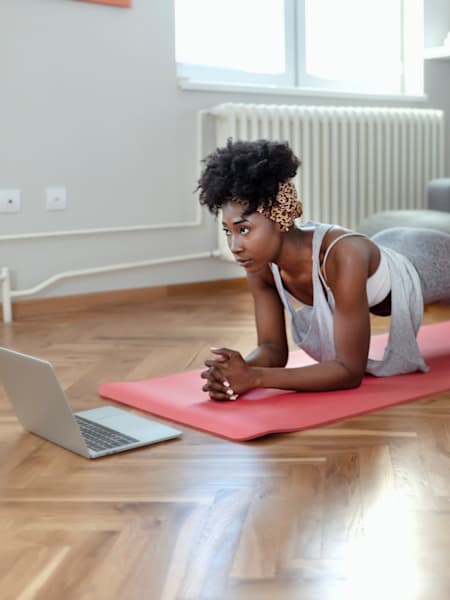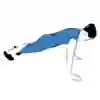Unless you've been living under a rock – or haven't checked your Insta feed – for the last few years, it's likely you've heard of high-intensity interval training, or HIIT.
It's the type of training that fitness bods have been taking to their lounges, gardens or local parks over the last few years to get fit, following workouts posted on social media by their favourite Lycra-clad fitness influencers.
But what's the deal with it? What exactly does it involve – and just how beneficial is it? Plus, how do you get started if you decide you want to jump on the bandwagon, albeit a few years late...
What is HIIT?
High-intensity interval training is a type of training involving short bursts of intensive exercise alternated by recovery periods of complete rest or less vigorous moves.
Why should I bother with HIIT?
Studies have shown that HIIT can improve your VO2 max by 15 percent
© Julian Sarracino / Red Bull Content Pool
First off, HIIT’s major benefit is just how accessible it is – you don’t need a gym pass or special equipment, just a small window of free time (a 20-minute workout is a great starting point), and a decent pair of trainers.
And, just as importantly, it's a phenomenal way to boost your cardiovascular fitness. In addition to building all-over muscle strength through exercises such as squats, press-ups and lunges, according to Chris Antoni, a personal trainer and CEO of Tailor Made Fitness, regular HIIT sessions improve your oxygen consumption and, as a result, produce greater improvements in fitness than longer bouts of moderate exercise.
One of the first studies into the effectiveness of HIIT found people who performed four minutes of intensive cycling on an exercise bike five times a week improved their VO2 max (that’s the uppermost rate at which your body can utilise oxygen for energy during exercise) by 15 percent after six weeks, compared to 10 percent by those who did moderate exercise five times a week.
HIIT is incredibly efficient at torching calories, too. A study published in the Journal of Strength and Conditioning Research found that HIIT burns 25-30 percent more calories than spending the same amount of time resistance training, cycling and running on a treadmill.
This effect continues after exercise as well. Exercising at a high intensity requires more oxygen than exercising at a moderate intensity (or indeed resting), meaning your metabolism has to work at a higher level. The body then burns more calories after you've finished as it works hard to resume its normal resting state.
Where do I start?
As Polly Hale, director of The Fit Mum Formula, explains, intense is a term that's relevant to you. As a beginner, it’s important to start off slowly, so don’t fling yourself in at the deep end with 30 minutes of burpy reps.
“If walking briskly for 20 seconds, followed by standing still for 30 seconds and repeating that pattern a few times is intense, then that’s a starting point and you can work towards more difficult exercises,” she explains.
Doing too much too soon can also be demotivating. Your fitness will build up quickly with regular intensive sessions, which will, in turn, help you work harder and for longer – and you’ll be far more likely to stick with it as you begin to see the results.
Antoni recommends beginners should check out YouTube videos at home first to get the basics right – it’s important to get your form and technique spot on to avoid injury.
Finding a beginners' class online can also be an effective way of getting you motivated, and give you a good foundation for you to then take further on your own. Alternatively, if it’s an option for you, a few sessions with a personal trainer can be a good introduction.
Get a plan
Identifying your goals will act as a metaphorical carrot. These targets don’t have to be big – they can be something as simple as being able to run for the bus. In fact, the more attainable the aim, the more likely it is you’ll stay motivated and focused. Once you know where you want to be, draw up a plan. This not only keeps you focused, but it is also a great way of tracking your improvement – another great motivator.
How intense should a workout be?
“The intensity of a workout depends on the individual’s fitness,” Antoni explains. “Try to push yourself as much as possible without injuring yourself. Remember, an effective workout is one done properly with good technique rather than bad technique.”
How often should you workout for maximum benefits?
Maximise your 150 minutes of recommended weekly exercise through HIIT
© Lin Cheng-De / Red Bull Content Pool
To get the most from HIIT, Antoni recommends doing intense exercise relevant to your fitness levels in 30-minute blocks, five times a week. But if three or four times a week is more realistic, then this is still enough for you to see results if you’re working hard and consistently.
“I believe it’s best to start with a 10-minute workout and build up to 15, 20, 30 minutes as stamina and strength improve. For a fairly fit person, that can be increased to 20 to 40 minutes, and if you’re very fit 40-60 minutes,” Antoni explains.
And if you’re really pushed for time, then doing even a minute is better than nothing. “If 60 seconds is literally all you can spare, do it the right way. You’ll get a surprising amount from one minute a day,” adds Polly.
Don’t forget to warm up
Be sure to loosen up first before taking on any sort of HIIT workout
© Alessandro Dealberto/Red Bull Content Pool
“I am a big believer in warming up as it gets your body ready for a challenging workout by increasing your heart rate and blood circulation," says Antoni. "Doing it right will loosen your joints and increase blood flow to the muscles." And make sure to follow a workout with dynamic stretches to decrease the risk of pulling a muscle and injuring yourself.
How do I stay motivated?
“The biggest motivational tip I can give is to stay consistent,” says Antoni. “Keep doing the right things, because if you do, I guarantee you will see the results you want. Yes, it will be hard but you must believe in yourself and keep positive.”
And don’t judge yourself against other people as this can quickly deflate you: “Understand this is your individual process and only you can get yourself fit,” explains Antoni. “Surround yourself with people who will keep you motivated and encourage you to stay on your fitness journey.”
Chris Antoni's 20-minute workout plan for beginners
Warm up
- Run on the spot (20secs)
- Jumping jacks (20secs)
- Heel flicks (20secs)
Repeat x5
Main workout
Each exercise should be completed for 30 seconds, with a 30-second rest after each repetition. Start off with two sets of the exercises and build it up as you start to feel stronger.
Exercise 1: Running on the spot with high knees.
Benefits: Engages your core, strengthens the muscles in your legs and gets your heart rate up. It also improves coordination and flexibility.
Method: Run on the spot, bringing your knees up as high as possible – try and touch your chest. Pump your arms, keeping them at 90 degrees and bring your elbows right back.
Exercise 2: Squat
Benefits: Improves strength in the quadriceps, hamstrings, calves and erector spinae (set of muscles in the back).
Method: Stand with your head facing forward and your chest held up and out. Place your feet shoulder-width apart or slightly wider. Extend your hands straight out in front of you to help keep your balance. Sit back and down like you're sitting onto an imaginary chair. Keep your head facing forward as your upper body bends forward a bit. Rather than allowing your back to round, let your lower back arch slightly as you descend. Lower down so your thighs are as parallel to the floor as possible, with your knees over your ankles. Press your weight back into your heels, and don't allow your knees to come over your toes. Keep your body tight, and push through your heels to bring yourself back to the starting position.
Exercise 3: Box press-ups/full press-ups
Benefits: Helps to develop upper-body strength as well as strength in your forearm and wrists.
Method: Position yourself on the floor with your weight on your hands (they should be shoulder-width apart) and your feet on the ground. Keep your body straight and lower yourself close to the ground before pushing back up. If this is too difficult, put your knees on the floor instead of the balls of your feet.
Exercise 4: Mountain climbers
Benefits: A great full-body exercise that builds cardio endurance, core strength, and agility.
Method: Start in a full press-up position, keeping your core engaged and your shoulders, hips and feet in a straight line. Bring one knee towards your chest, then return it to the starting position and repeat the movement with your other leg as quickly as you can.
Exercise 5: Lunges
Benefits: Targets the major muscle groups in your legs, increasing the strength of your glutes, hamstrings and calves. It's also a good exercise to promote better balance.
Method: Step forward with your right foot, bending at the hip and knee until your left knee is just above the ground. Push up with your right leg and bring your left leg up to meet it in front of you. Repeat on the alternate side.
Exercise 6: Dips
Benefits: Works your triceps while also improving strength in your chest and shoulders.
Method: Sit on a bench with your hands either side of you. Lower yourself towards the floor, keeping your hands on the bench and bending your arms to a 90-degree angle as you lower down. Pause for a second or two and raise up again.
Exercise 7: Plank
Benefits: Strengthens your inner core, transverse abdominis (deep abdominal muscle), multifidus (deep spine muscle), diaphragm, and pelvic floor.
Method: Lie on the floor. Lower your forearms to the floor with elbows directly under your shoulders, your hands shoulder-width apart and your arms at a 90-degree angle. Lift up, maintaining a straight line from your heels through to the top of your head. Focus on engaging your abs and hold.
Exercise 8: Side plank
Benefits: Primarily targets the obliques, but also works the whole side of the body including the shoulders, core and hips.
Method: On your side, stack your feet on top of each other. Place the forearm nearest the floor on the ground directly below your shoulder. Engage your core and raise your hips until your body is in a straight line from head to toe. Keep your shoulders down and away from your ears. Hold, and be careful not to let your hips drop.
Exercise 9: Ab crunch
Benefits: Targets the rectus abdominis – an inner layer of stomach muscles that help support the spine. Strong core muscles help improve your posture.
Method: Lie on your back, knees bent and feet flat on the floor, hip-width apart. Place your hands on your thighs, across your chest or behind your ears, depending on what feels most comfortable. Engage your core. Slowly curl up towards your knees until your shoulders are about three inches off the floor. Hold and lower yourself back to the ground.
Going all out on staying in this December? Go to redbull.co.uk/hometime for more tips on how to make the most of your home time and for the chance to get wiiings delivered to your door.





















